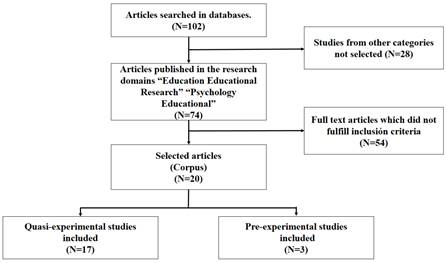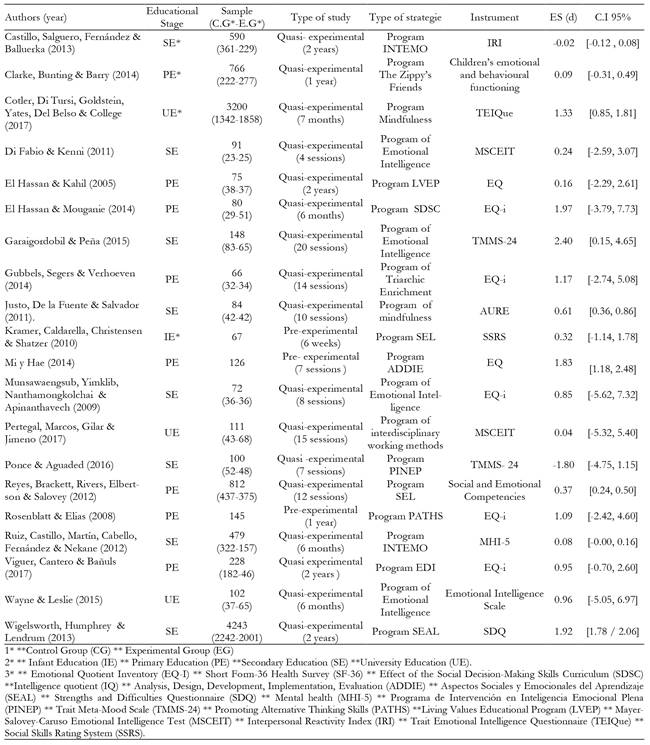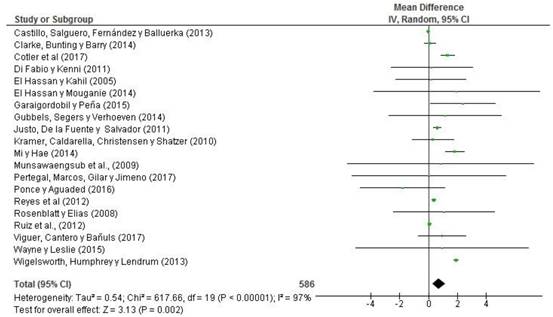Introduction
For some time now, levels of stress, anxiety and school failure are increasing and appearing at earlier educational stages (IsHak, Nikravesh, Lederer, Perry, Oguyemi & Bernstein, 2013). This can be due to certain factors such as increased responsibility and autonomy, academic work load, and lack of skills for managing emotions (Enns, Eldridge, Montgomery & González, 2018).
Hence, over the last decades, Emotional Intelligence is becoming progressively more important in the educational field since it promotes the psychological well-being of students, it enables a better understanding of their surrounding environment, and it provides them with the necessary skills to deal with the various situations that arise daily. Thus, this construct is established as an educational process that must be permanent and continuous, favoring the integral development of students (Bisquerra, 2009, Petrides, 2016).
Accordingly, correct acquisition and emotional utilization is closely linked to academic success, stressing the importance of content understanding versus rote learning (Dolev and Leshem, 2017, Suberviola, 2012). Therefore, it is necessary to encourage the development of the students' Emotional Intelligence given its great impact both at an educational level and at a social level.
In this same regard, according to Ortiz & Rodríguez (2011), emotional skills promote mental processes and also contribute to the concentration and to the control of stressful situations, as well as contributing to self-motivation and to carry out the students’ academic tasks and studies successfully.
Furthermore, students who reach good levels of Emotional Intelligence develop skills that help them to appropriately manage feelings such as anxiety and depression, and that increase their self-esteem, self-satisfaction with their work, and their satisfaction with the devoted effort, since they become able to use enough strategies to control their emotions and understand events, recovering faster and more effectively from negative moods (Asle-fattahi & Najarpo-Orostadi, 2014, Frederickson, Petrides & Simmonds, 2012).
This way, Emotional Intelligence is a construct that, although conceptualized by various authors, constitutes the most recent psychological approach to the development of emotions, refering to these four components: perception, understanding, management and emotional facilitation of cognitive activities (Mayer, Caruso & Salovey, 1999). Accordingly, it highlights the importance of emotional regulation and management in the students' performance, as well as the role it plays in mental well-being, both in the educational and in the social environments (Geng, 2018 Narwal & Sharma, 2018).
For this reason, with this study we intend to conduct a meta-analysis in order to analyze the effects of the interventions related to Emotional Intelligence that have been carried out, attending to the educational stage in which they are developed, the duration of the implementation, and the instruments that have been used.
Methods
Procedure
The scientific papers were reviewed from December 2017 to February 2018, selecting only those that carried out an implementation to improve the students' Emotional Intelligence in the educational sphere over the last two decades.
The main search engines used were the Web of Science, SCOPUS and PubMed with the keywords "Progam implementation", "Emotional Intelligence" and "Students", using the Boolean operators "and" & "or". At a later stage, the search was refined considering the articles published in the research domains "Education Educational and Research" and "Psychology Educational". In addition, only those articles that had been submitted to a peer review were taken into account.
The inclusion criteria used for the selection of the different studies was: 1) articles on emotional intelligence implementation programs, 2) studies that used students in the different educational stages as a sample, and 3) articles showing the necessary data to carry out the meta-analysis, that is, both means and standard deviations in order to obtain the effect size (ES) and the reliability of the programs (95% C.I).
For data processing, the logical order of data was compared and all the information was synthesized in order to achieve a reliable and up-to-date study. After applying the inclusion criteria, this study was based on 20 articles closely linked to the topic studied, being its process specified in figure 1.
Data Analysis
In order to compare the results of the implementations, the effect size (ES) was calculated using Cohen's d (1998) and the correlation index r. The mean values resulting from the control group and the experimental group during the post-test phase were also calculated, divided by the standard deviation to avoid estimation bias (Hedges & Olkis, 1985).
Subsequently, the Review Manager 5.3 program was used, obtaining a 95% C.I, with the purpose of calculating the confidence interval in the implementation of each of the studies. Finally, the Q-statistic was calculated to check the degree of heterogeneity of the ES, and the I 2 was used to find out the degree of heterogeneity of the ES.
Results
Data from the selected studies
For data mining, the following coding process was carried out: 1) Author/s, 2) Year of publication, 3) Educational stage in which the implementation was carried out, 4) Sample, 5) Type of study (Pre-experimental or Quasi-Experimental), 6) Instruments used to measure Emotional Intelligence, 7) Effect Size, and 8) 95% CI. (Table 1)
The articles selected as the corpus of the study were coded by the authors, in order to check the reliability of the coding. After comparing the articles, a 90% agreement was reached. The percentage of agreement was obtained by dividing the number of coincidences by the total number of categories, and multiplying it later by 100.
As stated above, the corpus of this study were 20 scientific articles with their Effect Size calculated. The mean of the Effect Size in the experimental groups was M = 0.73 (95% CI = 0.27, 1.18), which corresponds to a high effect following the criteria established by Cohen (1988), Hill, Blomm, Black & Lipsey (2008), and Valentine & Cooper (2003). Table 1 shows the Effect Size of each of the selected studies.
The value of Q (617.66; p < .001) shows that the effect sizes are heterogeneous. Additionally, resulting the statistic I2= 97% also means that the data are heterogeneous, confirming therefore that according to Huedo-Medina, Sánchez-Meca, Marín-Martínez & Botella (2006), the heterogeneity is high.
Figure 2 shows the forest plot enabling visual observation of the heterogeneity of Effect Sizes in each of the selected studies. To check whether the combined results of this meta-analysis are significant or not, we used the statistic Z = 3.13 (p < .002), which indicates a combined evidence denoting a non-null (significant) effect.
Evolution of the scientific production
The main documents used in this study correspond to the 19% of the total production of works on this subject in the databases WOSS, SCOPUS and PubMed. Figure 3 compares the total production of articles per year with those selected.
There is an upward trend in the total production of works that address the analyzed issue in the last two decades, this increase being considerably significant in 2016 (N = 15), followed by the years 2015 and 2017 (N = 13), while the greatest decline was found in 2005 (N = 2).
Table 2 shows the percentages of the countries where the various works that constitute the body of this study were produced, Spain (N = 7) being the country with the highest number of implementations, followed by the United States (N = 4) and the United Kingdom (N = 3).
Effects of the implementations considering the educational stage, duration and instruments used
Since the Effect Size of each of the studies that constituted the corpus of this study was already known, an analysis on the educational stage and duration of the implementation variables was carried out (Infant, Primary, Secondary and University). Table 3 shows the variables used together with their Effect Size and their 95% CI.
Considering the duration of the program carried out in the classroom, the highest Effect Size mean was found in the medium length implementations (ES = 1.13), followed by long-duration implementations (ES = 0.69), and the lowest values appearing in those lasting less than three months (ES = 0.34).
Considering the educational stages where the implementations were carried out, the greatest effectiveness was obtained in Primary Education (ES = 0.95), followed by University Education (ES = 0.77), and obtaining Infant Education and Secondary Education the lowest ES respectively (ES = 0.32, ES = 0.53).
Likewise, considering the nature of the instruments used (skills, performance, and personality traits), those related to personality traits obtained the best results (ES = 1.03), as oposed to instruments related to performance which obtained the lowest results (ES= 0.18).
Discussion
This study was aimed at discovering the effects that the Emotional Intelligence intervention programs bring about to students in the different educational stages. Various authors confirm that Emotional Intelligence plays a key role in the academic performance of students, as well as in their social and mental well-being (Di Fabio & Kenni, 2011; Munsawaengsub, Yimklib, Nanthamongkolchai & Apinanthavech, 2009).
In addition, they have revealed that emotional skills provide students with the required ability to make appropriate decisions under stress, as well as helping them with emotional regulation in avoiding stressful situations. Those who reach high levels of Emotional Intelligence have a better self-perception of their effectiveness, besides avoiding feelings of attrition related to the academic environment surrounding them (Cotler, Di Tursi, Goldstein, Yates & Del Belso, 2017; Garaigordobil & Peña, 2015; Ruiz, Castillo, Martín, Cabello, Fernández & Nekane, 2012).
The results presented by the programs carried out to improve the students' Emotional Intelligence highlight that the students belonging to the experimental group improved self-perception of their own academic vision through the implementations. In addition, the LVEP program provided improvements at the social level by developing interpersonal and intrapersonal skills (Clarke, Bunting & Barry, 2014; El Hassan & Kahil, 2005; Pertegal, Marcos, Gilar & Jimeno, 2017).
These results extended due to the fact that students had contexts in which they could put into practice these emotional skills. These data are very similar to those found in the study carried out by Fregoso-Bailón, López-Peñaloza, Navarro-Contreras & Valadez-Sierra (2013), in which a sample of 140 secondary students, by means of the implementation, improved the perceived Emotional Intelligence and their empathy towards others by generating contexts where they could talk and listen to others besides favoring respect.
Other studies that confirm the benefits that Emotional Intelligence programs report are those by Garaigordobil & Peña (2015) and Reyes, Brackett, Rivers, Elbertson & Salovey (2012), which affirm that by the implementation of these programs, attention, clarity and emotional regulation are improved, and also an optimal intrapersonal development can be achieved, since an improvement in their own self-perception means a better emotional understanding and respect of others, besides reducing tense situations more optimally both academically and personally (Castillo, Salguero, Fernández & Balluerka, 2013, Di Fabio & Kenny, 2011; Waine & Leslie, 2015).
However, other studies such as the one carried out by Ponce and Aguaded (2016), show that after the PINED program intervention, the students in the experimental group did not obtain significant differences compared to the students of the control group in the perceived Emotional Intelligence and the emotional clarity, results which are very similar to those obtained in the study by Castillo, Salguero, Fernández, & Balluerka (2013), on a sample of 590 secondary students.
On the other hand, studies such as those by Di Fabio & Kenni (2011) and Gubbels, Segers & Verhoeven, (2014) show that the use of Emotional Intelligence programs on students improve their self-confidence as well as helping them overcome indecision. In addition, all the students belonging to the experimental group improved in all the Emotional Intelligence dimensions, thus positively affecting decisión-making within the academic and social environment, reducing feelings of restlessness, anxiety, and negative sensations.
Other relevant studies that concur with the suggested ideas are those by Cotler, Di Tursi, Goldstein, Yates, Del Belso & College, (2017) and Justo, De la Fuente & Salvador (2011). They establish that through the practice of mindfulness, part of the benefits are gained a posteriori, achieving the students full self-awareness which helps them to control and understand the various situations that arise every day, and also increasing their self-fulfillment regarding their own tasks.
In addition, other studies such as those by Ruiz et al. (2012), and Viguer, Cantero & Bañuls (2017), state that emotional development contributes to determine well-being, to effectively manage emotions, and to prevent psychological problems by improving the control of stress and anxiety, problems which are currently becoming a social alarm, as well as to optimally improve interpersonal skills, learning therefore how to understand themselves and others.
In this sense, Kramer, Caldarella, Christensen, & Shatzer (2010) and Ruiz, Castillo, Salguero, Cabello, Fernández & Balluerka (2012), support with their results that the levels of Emotional Intelligence together with cognitive abilities act as a potential predictor both of the psychological balance of students, and of their academic achievement, since it provides them with the necessary and sufficient skills to know themselves and to be able to empathize with others.
Therefore, the development of Emotional Intelligence intervention programs at an early age proves especially important. This construct helps young people acquire the ability to deal with conflict situations in an optimal way, thus contributing to mental wellbeing and academic performance of students.
Conclusion
The data analysis concluded that 90% of the implementations produce high positive effects on the students, such as the improvement of their emotional and social skills, their ability to face the academic difficulties that arise daily in the classroom, and the regulation of their emotions.
In terms of scientific evolution, it is important to point out that it has been in the last decade when this topic has achieved greater importance, since implementation programs have started to be carried out in order to improve the Emotional Intelligence of students, due to the current alarming situation caused by the large number of students suffering from stress, anxiety and depression. However, the number of studies is still nowadays very scarce. Spain is the country with the most implementations, according to the results found in the WOSS, SCOPUS and PubMed databases.
Regarding educational stages, most of the studies deal withPrimary and Secondary Education, being Infant Education the only stage where a single study was found. Regarding the effectiveness of the programs, the best results were found in Primary Education, which highlights the need to start developing implementations to improve Emotional Intelligence from an early age, since they provide great benefits.
Besides, the education system should provide and contribute to the development of the resources required to facilitate and help them overcome the various conflict situations that arise during that evolutionary period, resources which enable self-understanding and a flexible and open attitude towards change.
Additionally, regarding the duration of the implemented programs, the most effective ones were those that had a medium length duration, being short duration programs the ones showing the lowest effectiveness. In the same way, those using instruments related to personality traits for their evaluation obtained the best results, as opposed to those using performance instruments which obtained the lowest.
Regarding the limitations of the study, it can be highlighted that the number of studies that constitute the corpus is not very high, so it would be necessary to check more databases in order to compare the effects and the confidence interval of each program in the different educational stages, their duration and even the instruments used.











 texto en
texto en 








